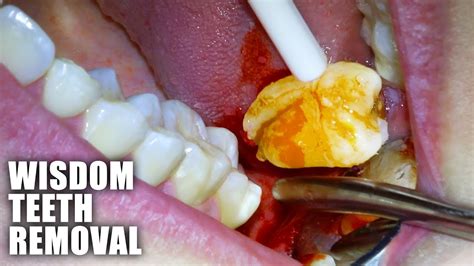10 Oral Sedation Tips For Wisdom Teeth Removal

When it comes to wisdom teeth removal, one of the most significant concerns for patients is the anxiety and discomfort associated with the procedure. Oral sedation has become a highly effective method to alleviate these concerns, allowing patients to undergo wisdom teeth removal with minimal stress and discomfort. However, to ensure the best possible experience, it’s crucial to understand the ins and outs of oral sedation for this procedure. Here are 10 oral sedation tips specifically tailored for wisdom teeth removal, designed to guide you through the process with confidence.
1. Understand the Types of Sedation
Before undergoing wisdom teeth removal with oral sedation, it’s essential to understand the different types of sedation available. Oral sedation can range from minimal to moderate, depending on the patient’s needs and the complexity of the procedure. Discussing your options with your dentist or oral surgeon will help determine the most appropriate level of sedation for your case.
2. Pre-Sedation Instructions
Following pre-sedation instructions is critical for the safety and effectiveness of the procedure. Typically, patients are advised not to eat or drink anything for a certain period before the procedure. Adhering to these instructions will minimize the risk of complications during the sedation and ensure a smooth recovery.
3. Choose the Right Sedation Medication
The choice of sedation medication can significantly impact your experience. Commonly used medications include triazolam, lorazepam, and midazolam, each with its own benefits and drawbacks. Your dentist or oral surgeon will prescribe the most suitable medication based on your medical history, the procedure’s complexity, and your personal preferences.
4. Plan for Transportation
One of the most critical aspects of oral sedation is planning for transportation after the procedure. Due to the effects of the sedation, which can include drowsiness and impaired judgment, it’s mandatory to have someone accompany you to the procedure and drive you home afterward. This ensures your safety and compliance with the post-procedure instructions.
5. Follow Post-Procedure Care
The recovery period after wisdom teeth removal with oral sedation requires careful attention. Your dentist or oral surgeon will provide detailed post-procedure instructions, which may include a soft food diet, pain management, and hygiene routines. Following these instructions meticulously will help in healing, minimize the risk of complications, and ensure the sedation effects wear off without issues.
6. Monitor for Complications
While oral sedation is generally safe, it’s crucial to be aware of potential complications. These can include respiratory depression, nausea, and increased heart rate. Monitoring your condition closely after the procedure and reporting any unusual symptoms to your healthcare provider can help manage any adverse effects promptly.
7. Combine with Other Sedation Methods
In some cases, oral sedation may be combined with other sedation methods, such as nitrous oxide, to enhance its effects. This approach can provide a more comfortable experience, especially for patients with high anxiety levels. However, the decision to combine sedation methods should be made in consultation with your dentist or oral surgeon, considering your health status and the specifics of your procedure.
8. Discuss Your Medical History
Informing your dentist or oral surgeon about your complete medical history, including any medications you’re currently taking, is vital. Certain medications can interact with sedation drugs, and pre-existing medical conditions may affect how you respond to sedation. This information will help your healthcare provider make informed decisions about your sedation plan.
9. Consider the Cost and Insurance Coverage
Oral sedation for wisdom teeth removal may incur additional costs compared to procedures performed without sedation. Understanding your insurance coverage and the out-of-pocket expenses involved will help you plan financially. Discussing costs and payment options with your dentist or oral surgeon ahead of time can alleviate financial stress and make the process smoother.
10. Evaluate Your Anxiety Level
Lastly, it’s essential to honestly evaluate your level of anxiety regarding the procedure. Oral sedation is most beneficial for patients who experience significant apprehension or fear. If you’re considering oral sedation for wisdom teeth removal, discussing your anxiety level with your dentist or oral surgeon will help determine if sedation is right for you and to what extent.
In conclusion, while oral sedation can significantly enhance the experience of wisdom teeth removal, being well-informed and prepared is key. By understanding the process, following instructions carefully, and maintaining open communication with your healthcare provider, you can ensure a safe, comfortable, and successful procedure.
How long does it take for oral sedation to wear off after wisdom teeth removal?
+The duration for oral sedation to wear off can vary depending on the medication used, the dosage, and individual factors such as metabolism. Generally, the effects of oral sedation can last anywhere from a few hours to a full day, with most patients feeling back to normal within 24 hours.
Can I drive myself home after wisdom teeth removal with oral sedation?
+No, it’s not recommended to drive yourself home after undergoing wisdom teeth removal with oral sedation. The sedation can impair your judgment and reaction times, making it unsafe to operate a vehicle. It’s essential to have someone accompany you to the procedure and drive you home afterward.
Are there any potential risks or side effects of oral sedation for wisdom teeth removal?
+While oral sedation is generally safe, there are potential risks and side effects to be aware of. These can include respiratory depression, nausea, drowsiness, and increased heart rate. Monitoring your condition closely after the procedure and reporting any unusual symptoms to your healthcare provider is crucial for managing any adverse effects.
